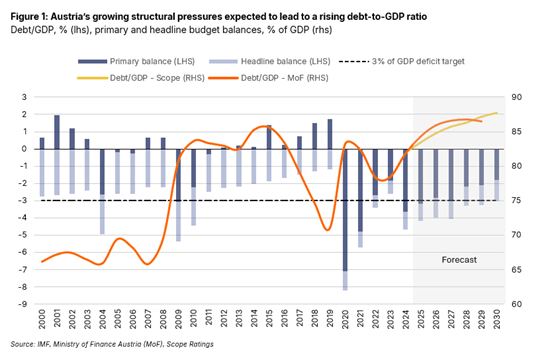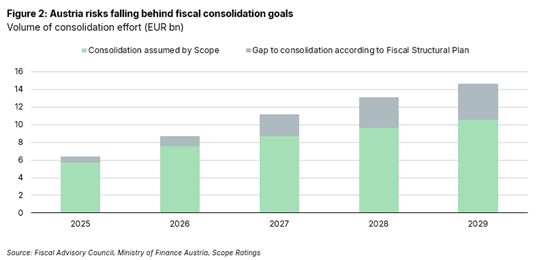Announcements
Drinks
Austria: persistent fiscal pressures coupled with weak growth challenge resilience to future crises
By Eiko Sievert and Elena Klare, Sovereign and Public Sector
Improving the sustainability of Austria’s (AA+/Stable) debt burden is important to build resilience against future crises. The recent series of external economic shocks – including the pandemic, the escalation of Russia’s war in Ukraine and the economic slowdown among some important trading partners – has accelerated the structural weakening of Austria’s economic growth and government finances.
We expect the economy to stagnate in 2025 after two years of contraction. Economic output stood just 1.7% above pre-Covid levels in Q2 2025, a level well below the euro area average of +6.5% and near the bottom of Austria’s peer group alongside Finland (AA+/Negative) at +0.7%.
Austria’s export-orientated industries, including automotive and steel, remain vulnerable to volatile energy prices and higher tariffs amid heightened tensions in US-Europe-China trade relations. We expect economic growth to average around 1% a year in the next five years, well below the 2% in the five years before the pandemic.
Austria’s public finances reflect a combination of the lingering strain the economy is under, alongside growing structural pressure on government expenditure. The fiscal deficit of 4.7% of GDP last year was the third highest since 2006, only exceeded during the global financial crisis in 2009 and the 2020-21 pandemic.
Cost-of-living pressures and spending increases linked to Austria’s ageing population will likely lead to continued high primary deficits unlike during the two decades leading up to the pandemic when successive governments recorded moderate headline deficits and regular primary surpluses during non-crisis years (Figure 1).

Further consolidation efforts needed to stabilise the debt trajectory
We estimate that the government will save only around EUR 10.6bn of a projected EUR 14.6bn in the coming years. If so, the government will miss its 3% deficit target by 2028. Debt would gradually rise to 88% of GDP by 2030, up from 82% in 2024 and well above the peer-country average of around 60%.
The EU placed Austria under an Excessive Deficit Procedure (EDP) in early July, with a recommendation to reduce net expenditure growth and meet the 3% deficit target by 2028. The Austrian government had submitted its Medium-Term Structural Fiscal Plan to the European Commission in May which outlined EUR 14.6bn of required consolidation until end-2029 to stabilise the debt trajectory. However, based on progress to date, full implementation looks challenging amid continued high spending pressures, not least to offset weakening economic activity.
The pressure Austria is under from Brussels to improve its fiscal position contrasts with AA+-rated peer Finland which avoided an EDP as the country’s higher defence spending was taken into account. Still, we revised Finland’s sovereign credit Outlook to Negative on 1 August reflecting the country’s weakening fiscal prospects.

Inflation, structural nature of higher public spending complicate budget tightening
Growth in Austrian public spending last year, up 8.7% from 2023, continued to surpass the increase in revenue, up only 4.9%, as higher welfare and public-sector wage costs offset the phase-out of most measures designed to protect households and business from the cost-of-living crisis.
Austria’s budgetary challenge partly stems from fiscal slippage at the provincial and local levels. Planned consolidation in 2025–2026 relies mainly on cuts to state, local, and social security budgets, as the central government’s deficit is expected to remain stable. However, sub-sovereign governments also face fiscal pressure, notably from high staff costs.
Structural spending related to Austria’s ageing population represents longer-term pressure on public finances, the response to which will require streamlining healthcare services and further pension reform. The government estimates that pension costs will rise to EUR 38.2bn (6.7% of GDP) in 2029 from EUR 30.0bn (6.2% of GDP) in 2024.






